HOSTS- Jeremy Burns, Matthew Scott Phillips
TYPE- Ear Training
DURATION- 98:00
BUMPER MUSIC- "Hey Lonely Guy" (Area 47 Music)
ANNOUNCER- Mike Cunliffe
Continuing where episode 98 left off, we will top off our ear training of secondary seven chords. We will listen how to tonicize the IV chord (in major and minor) and the VII chord in (minor). Then, we will test our ears with some chord progressions...a.k.a. Jeremy Torture!

The following examples reflect the opening examples on episode 109. Though the arrangement of notes may not be 100% accurate, the progressions will be the same.






Let's take four listens to identify this chord progression. Below is a good strategy on how to use your listens wisely for each time the progression is played.
1st LISTEN-THE BASS
Use this listen to focus on the bass line. In our first example, we hear the following scale degrees in the bass, beginning with scale degree 1. We are in the key of C. So this will be a C note:
1 - 2 - 3 - 4 - 5 - 1
Notate it!

2nd LISTEN-THE SOPRANO
Use this listen to focus on the melody, or the soprano voice. When you hear that note, try to identify what scale degree it is and where it goes from there. Sometimes singing (in your head), from the identified note down to the the tonic, can help zero in on what scale degree it is. In this case, we hear that scale degree 1 begins the following progression in the highest voice:
1 - 2 - 2 - 1 - 7 - 1
Notate it!

3rd LISTEN-THE THEORY BRAIN
Something harmonic is coming together! We now have enough information to ENGAGE OUR THEORY BRAIN and start making educated guesses at how this progression might develop. Now, we will listen for chord qualities. Here's an example of the process:
Measure 1 sounds major, we have two C's. We're in C major.
Let's presume this to be a C major chord (I).
Measure 2 sounds minor. We have two D's (scale degree 2).
Let's presume this to be a D minor chord (ii).
Measure 3 sounds weird! We have a D and an E.
We'll put a question mark by it. But we know these two notes could members of an
Eø (half-dimished) chord.
Measure 4 sounds major. We have an F and a C. These are both in F major (IV)
Let's presume this to be an F major chord (IV).
Measure 5 sounds major. We have a G and a B. These are both in G major (V)
Let's presume this to be a G major chord (V).
Measure 6 sounds major. We have two C's. These are both in C major (I).
It feels final!
Let's presume this to be a C major chord (I).

4th LISTEN-CONFIRMATION
Ideally, this listen will be your confirmation listen. Check out all the voices you filled in and make sure they make sense with what you're hearing.
Here's what it will look like:

NOW LISTEN AS WE APPLY THIS APPROACH TO THE NEXT EXAMPLES
-When trying to determine which scale degree is in the highest voice, try singing down the scale from that note. If you feel you've reached the TONIC on the 3rd note down, that note is the 3rd. If you can keep going, perhaps not.
-Try practicing progressions using these chords, using CHORALE or KEYBOARD styles.
-Don't neglect the MINOR keys while working on these progressions.
-Try to get good at singing "in your head" or to your self. When you hear a chord, try to arpeggiate the notes in your head.
-Try to get good at identifying the bass lines when listening to music. These will be the first that you will want to identify when taking your listening exams.
-Budget your listens wisely. First identify the lowest notes. Second, identify the highest notes. Use the third listen to engage your theory brain and then the fourth to confirm.

